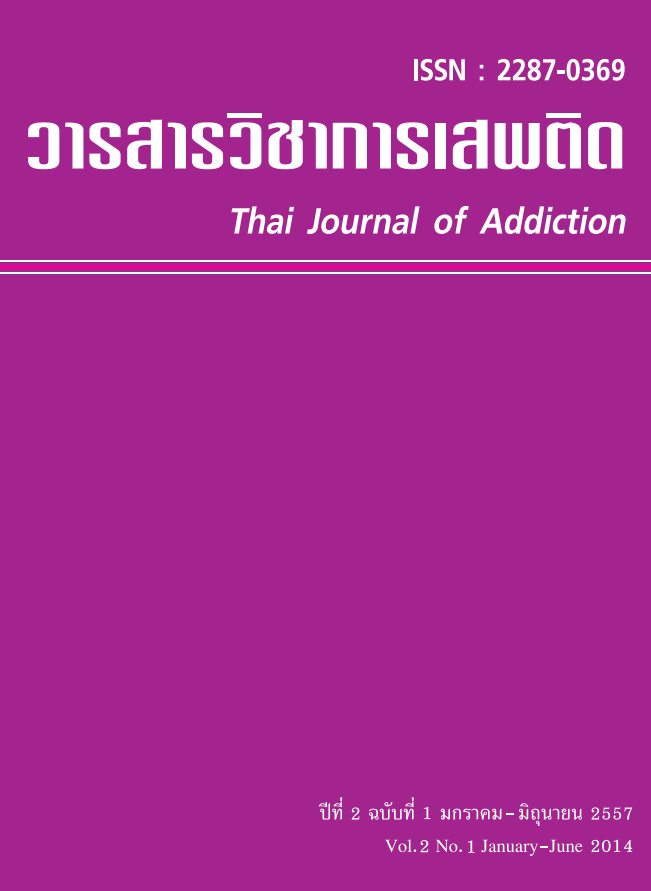Characteristics and Occupations of drug users
Keywords:
drug users, Occupations, CharacteristicsAbstract
The objectives of this survey research were to study characteristics, occupational training needs and relationship between sociodemographic data in terms of characteristic and occupations of drug abuse at Thanyarak Institute and 6 Regional Drug Treatment Center. The 720 samples were selected. The 696 samples were quantitative questionnaires and 24 samples were in-depth interview. The research instruments were questionnaires and in-depth interviews in relation to occupations of drug abuse. Psychometric testing of instruments were approved by experts. Data were collected between March-April 2012 for a period of 45 days. Qualitative data was analyzed by content analysis and quantitative data were analyzed by frequency, percentage, mean, standard deviation and Chi-square.
The finding of this study showed that mean age was 30 years old. Most of them were male, educational background was secondary school (48.3%) and primary school (26.7%) respectively. For types of drugs were Amphetamine (55%), alcohol (23%) and Ice (13%) respectively and Ice is the only drug that woman use more than men to 2-fold. It was found that most drug users were unemployed (22.2%), and work on commercial and service settings (16.6%), agriculture (14.7%) and labor (13.6%) respectively. The other occupations were general labor, technician, farmer, gardener, merchant and motorcycle taxi driver. The occupational training needs were industrial technician (28%), agriculture (21%), cooking (16%), art (14%), commerce and service (13%) respectively. According to the relationship between characteristics and occupations of drug abuse, it was found that gender, age, level of education, and drug use were associated with occupations of drug abuse significant at the .05 level.
The results of this study indicates that policy and defensive measure regarding monitoring system about use of drugs in the risk group such as unemployment, workers, night workers, shift workers are very helpful policy implementation of those groups should be integrated to the relevant agencies; occupational training, development of skilled labor, and the provision of resources to support occupations.
References
2. วิภาวดี แสงเพชร และวิมล ลักขณาภิชนชัช. การพัฒนาคุณภาพชีวิตผู้ป่วยยาเสพติดโดยการพัฒนาการฝึก อาชีพในผู้ป่วยระยะฟื้นฟูสมรรถภาพ. รายงานวิจัย 2551.
3. วันเพ็ญ ใจปทุม. การประกอบอาชีพของผู้ติดยาเสพติด : โครงการพัฒนาวางแผน. (สารนิพนธ์หลักสูตร ปริญญาการศึกษามหาบัณฑิต). จิตวิทยาการแนะแนว. บัณฑิตวิทยาลัย มหาวิทยาลัยศ รีนครินทรวิโรฒ; 2543.
4. กรมสุขภาพจิต. อาชีพไหนเครียดที่สุด. [สืบค้น 1 กรกฎาคม 2555]. เข้าถึงได้จาก: http://blog.eduzones.com/snowytest/81882.
5. Fuller, R.K. & Hiller-SturmhÖfel, S. Alcoholism treatment in The United States. Alcohol Research & Health. 1999; 23(2):69-77.
6. Krejcie & Morgan D.W. ตารางกำหนดขนาดตัวอย่าง. [สืบค้น 20 มกราคม 2555]. เข้าถึงได้จาก : http://www.watpon.com/table/mogan.pdf.
7. กองวิจัยตลาดแรงงาน. สถานการณ์การว่างงาน การเลิกจ้างและความต้องการแรงงาน (มีนาคม 2555). [สืบค้น 21 เมษายน 2555]. เข้าถึงได้จาก: http://lmi.doe.go.th/images/file/
unemployment/unemployment_0355.pdf.
8. กองวิจัยตลาดแรงงาน. แนวโน้มความต้องการแรงงานในช่วงปี 2553-2557. กรุงเทพฯ: กรมการจัดหางาน กระทรวงแรงงาน; 2552.
9. สำนักงานปลัดกระทรวงแรงงาน. ประกาศคณะกรรมการค่าจ้าง เรื่อง อัตราค่าจ้างขั้นต่ำ 2555. [สืบค้น 27 กรกฎาคม 2555]. เข้าถึงได้จาก: http://ratchaburi.labour.go.th/dlpw/attachments/143_
labour1.PDF.
10. ปิ่นรัฐ ปานถาวร. การประกอบอาชีพของนักโทษเด็ดขาดหญิงก่อนเข้าสู่ทัณฑสถานหญิงกลาง. (สารนิพนธ์ หลักสูตรพัฒนาแรงงานและสวัสดิการมหาบัณฑิต). คณะสังคมสงเคราะห์ศาสตร์. มหาวิทยาลัย
ธรรมศาสตร์; 2550.
11. สำเนา นิลบรรพ์, พิทักษ์ สุริยะใจ, รัตนา ดีปัญญา, สมบัติ มากัน, วัชรี มีศิลป์ และนันทา ชัยพิชิต พันธ์. กระบวนการเสพติดผลกระทบต่อสุขภาพและครอบครัวของผู้เสพยาเสพติดกลุ่ม Club Drugs. รายงานวิจัย 2554.



